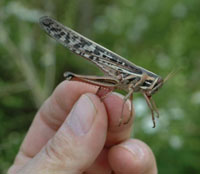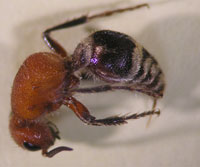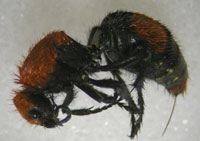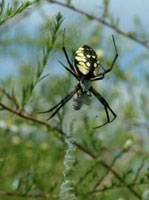
![]() Infestations of root mealybugs were reported in the August 25, 2008 (#1176) issue of the Kentucky
Pest News. The specimens were identified by a specialist with the Florida Department of
Agriculture and Consumer Services as the trochanter mealybug (Pseudococcus sorghiellus). The species was described from insects collected from sorghum in Illinois in 1855.
Infestations of root mealybugs were reported in the August 25, 2008 (#1176) issue of the Kentucky
Pest News. The specimens were identified by a specialist with the Florida Department of
Agriculture and Consumer Services as the trochanter mealybug (Pseudococcus sorghiellus). The species was described from insects collected from sorghum in Illinois in 1855.
This mealybug can feed on a variety of plant species. Many are legumes including alfalfa, red clover, white clover, and soybean but it has been found on corn, Johnsongrass, and sorghum, too. It has been collected from curly dock, milkweed, and plantain; there are some trees on the host list, too.
The trochanter mealybug was found on stressed soybeans in Bourbon and Fleming counties. A quick check of red clover on Spindletop farm in Fayette County turned up some red clover in pasture grasses with heavily infested roots. It is likely that the insect is widely distributed in the state and high populations will be associated with continuous legume production. The species is listed from all of our neighboring states and seems to occur over virtually all of the eastern US.
For more information about soybean pests, visit
"Insect Management Recommendations".


 The American bird grasshopper is a spectacular sight as it flies through the air. This large species not only seems to be the size of a small bird as it flies but the adults roost in trees and shrubs at night and will tend to fly to trees during the day if disturbed. They are most likely to be seen in pastures or overgrown areas where they fly off rapidly if approached. While they can be destructive pests farther south, their numbers are relatively low here. They are an unusual sight.
The American bird grasshopper is a spectacular sight as it flies through the air. This large species not only seems to be the size of a small bird as it flies but the adults roost in trees and shrubs at night and will tend to fly to trees during the day if disturbed. They are most likely to be seen in pastures or overgrown areas where they fly off rapidly if approached. While they can be destructive pests farther south, their numbers are relatively low here. They are an unusual sight.

Two cases of downy mildew on were confirmed on cucumber on September 10th and 11th. The first outbreak was found in sentinel plots located at the Robinson Station in Quicksand and second case was located in Allen County. Please be on the lookout for downy mildew on cucurbits in the field, and note that we will have conditions that favor development and spread of this disease in the coming days. Downy mildew on cucurbits is an aggressive, fast-moving disease and can be really hard to stop when it gets started. Under the right conditions, infection levels can go from 10% of leaf area infected to 90-100% in less than a week!
Identifying downy mildew on cucurbits can be a little tricky, because symptoms on each species vary to some degree. What's more, downy mildew can be confused with powdery mildew. Both of these diseases are similar in that they are caused by obligate pathogens, meaning that the pathogen must be associated with a host plant to survive. The downy mildew pathogen, Pseudoperonospora cubensis, is not a true fungus. It belongs to the Oomycetes and is related to the pathogen that causes blue mold of tobacco; however, powdery mildew is caused by Podosphaera xanthii and belongs to the Ascomycete group of "true" fungi. Although downy mildew is more common in wet weather, fogs and heavy dews can contribute enough moisture to allow infection during "dry" weather. Powdery mildew is more likely to be a problem when conditions are warm and dry, and it tends to develop gradually over the course of several weeks. In terms of symptoms, the two diseases can be confused. Early on, both can cause yellow spots on the upper surface of a leaf. In the case of downy mildew, leaf spots tend to be small, blocky, and are limited by leaf veins, while spots associated with powdery mildew are round and somewhat diffuse. On the underside of a leaf with downy mildew, lesions will initially appear sunken and slightly water-soaked. As downy mildew progresses, infected leaves will take on a scorched appearance. Leaf yellowing (chlorosis) is more common with powdery mildew, and infected leaves will be covered with a white, talc-like, superficial growth (from which powdery mildew takes its name) that tends to favor the upper leaf surface; however, it is not uncommon to find colonies of the powdery mildew fungus on lower leaf surfaces, stems, or vines and even fruit if disease is severe. One of the key features of downy mildew is the pattern of sporulation, which occurs only on the underside of an infected leaf and has a faint, fuzzy or "downy" appearance. It is easier to observe sporulation with downy mildew in the morning when there's plenty of leaf wetness. It's very easy to distinguish the downy and powdery mildew pathogens at the microscopic level; sporangia of downy mildew are formed on sporangiophores that have a distinctive branching pattern that gives them the appearance of "deer antlers". Conidia of powdery mildew are formed in chains on relatively simple structures. If downy mildew is suspected, send a sample in to the Plant Disease Diagnostic Lab in Lexington or Princeton for examination.
At this point, and as weather permits, growers who are not on a preventive fungicide program should consider an application as soon as possible; spray intervals need to be fairly tight - in the 7-day range if possible. Chlorothalonil and, to a lesser extent, mancozeb (or maneb for pumpkin and winter squash) offer reasonable protection against downy mildew if sprayed on a regular schedule; there are several downy mildew-specific materials that can be used as well, such as Acrobat (or its liquid counterpart, Forum), Ridomil Gold Bravo (Ridomil-resistant strains of the downy mildew pathogen are common, so this option is questionable), Revus (a new fungicide from Syngenta - very active against downy mildew), Presidio (a new material from Valent, and a strong performer), and Ranman (ISK / FMC product). Please see ID-36, the 2009-2009 Vegetable Production Guide for Commercial Growers, for rate. Note that we are not recommending strobilurins (Quadris, Cabrio, Reason, Flint) for control of downy mildew, as resistance to this class of chemistry is high in the strains of P. cubensis in the U.S., and these compounds have lost much of their effectiveness against downy mildew.



 Velvet ants can be found wandering across turf areas during late summer and early fall. A furry
ant-like body and bright red or themselves effectively with a long stinger and venom orange
markings causes them to stand out and serves as a warning to leave them alone. These solitary
wasps are not aggressive but will defend that provides a painful aftermath to those unfortunate
enough to be stung (right picture). This can happen if they are accidentally stepped on with bare feet or picked up to be examined as a curiosity. Usually, this happens only one time.
Velvet ants can be found wandering across turf areas during late summer and early fall. A furry
ant-like body and bright red or themselves effectively with a long stinger and venom orange
markings causes them to stand out and serves as a warning to leave them alone. These solitary
wasps are not aggressive but will defend that provides a painful aftermath to those unfortunate
enough to be stung (right picture). This can happen if they are accidentally stepped on with bare feet or picked up to be examined as a curiosity. Usually, this happens only one time.
Velvet ants are free-living wasps that occur in grassy areas which they wander in search of bumble bee nests or the burrows of other ground-dwelling insects. The immature stages of these insects are the food of grub-like velvet ant larvae. As solitary wasps, velvet ants have no nest or home to try to eliminate. The best course is to be aware of them to train children playing in areas where the wasps are present to leave them alone.


 The golden argiope is one of the more spectacular and sometimes most alarming of the spiders that we see in early fall. They may bite if bothered but are not considered dangerous.
The golden argiope is one of the more spectacular and sometimes most alarming of the spiders that we see in early fall. They may bite if bothered but are not considered dangerous.
This orb weaver spider makes a flat, wheel-like web with silk lines radiating out like spokes from the center. Webs are usually in sunny overgrown areas where tall grass or brambles can support the web structure, which may be up to 2 feet across.
The golden argiope, or black and yellow garden spider, likes to hang head down in the center of its web. While resting, the spider often holds its legs together in pairs so there seems to be 4 legs rather than 8. In the picture at the right, it is feeding on a silk-wrapped insect that it has captured and trussed up. Having poor vision, the spiders rely on vibrations of trapped victims to know that their web has captured a meal. They may take prey up to twice their size, using their long legs and silk to efficiently immobilize the struggling meal.
A zig-zap or zipper pattern from the center to the bottom also results in them being called writing spiders. This once was thought to provide structural stability to the web or to attract flying insects. Another idea is that the "zipper" gives the web higher visibility so that birds are less likely to fly thru and destroy the web. The spiders are not giving away any secrets.


According to a statewide poll of Kentucky householders, 93% expressed concern over finding insects inside their home. More than half indicated that a single cockroach, cricket, or spider would prompt them to use a can of bug spray or call an exterminator. What many people do not realize, is that most pests discovered indoors have crawled or flown in from outdoors.
One of the best ways to limit unwanted intrusions by insects, mice, squirrels, raccoons and other pests is to deny them entry- a procedure known as pest proofing. Many pests seek refuge in homes and buildings in response to changes in weather, such as extended periods of rain or drought, or the onset of cool autumn temperatures. Taking steps to deny their entry before they end up inside can greatly reduce the chance of future sightings.
Outlined below are six tips for pest proofing one's home or business. Steps 1-3 will also conserve energy and increase the comfort level during winter and summer. Equipment and materials can be purchased at most hardware or home improvement stores.


August 29-September 12, 2008
UKREC-Princeton, KY
| Black Cutworm
| 5
| True Armyworm
| 19
| Corn Earworm
| 147
| European Corn Borer
| 2
| Southwestern Corn Borer
| 14
| Fall armyworm
| 22
| | |
Lexington, KY
| Black Cutworm
| 0
| True Armyworm
| 30
| Corn Earworm
| 17
| European Corn Borer
| 0
| Southwestern Corn Borer
| 0
| Fall armyworm
| 9
| | |
Graphs of insect trap counts are available on the IPM web site at - http://www.uky.edu/Ag/IPM/ipm.htm. View trap counts for Fulton County, Kentucky at - http://ces.ca.uky.edu/fulton/anr/
NOTE: Trade names are used to simplify the information presented in this newsletter. No endorsement by the Cooperative Extension Service is intended, nor is criticism implied of similar products that are not named.
Lee Townsend
Extension Entomologist